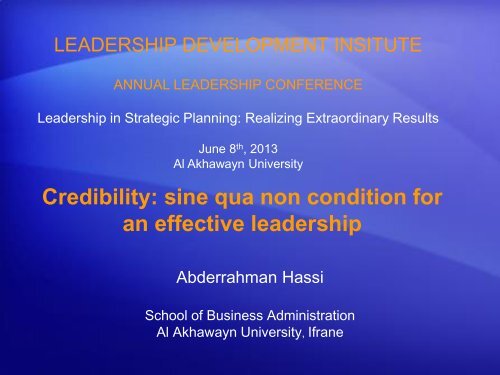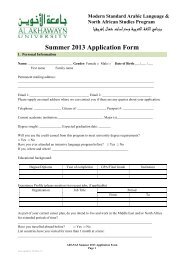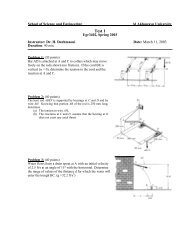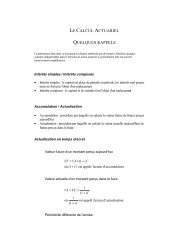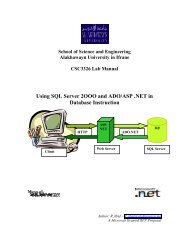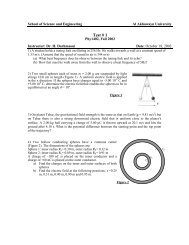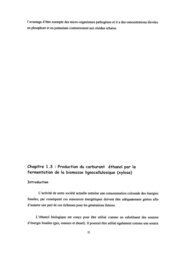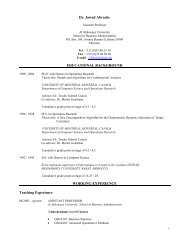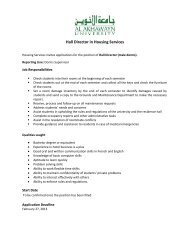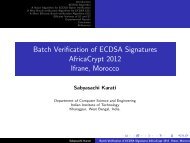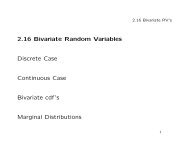Credibility: sine qua non condition for effective Leadership
Credibility: sine qua non condition for effective Leadership
Credibility: sine qua non condition for effective Leadership
Create successful ePaper yourself
Turn your PDF publications into a flip-book with our unique Google optimized e-Paper software.
Outline Introduction Literature Review Methodology Results Discussion Conclusion<strong>Credibility</strong> and <strong>Leadership</strong>
Introduction <strong>Credibility</strong> of managers is positively related to theirrelations with their employees (Mayer, Davis andSchoorman, 1995), to the efficiency of employee trainingand development (Hassi, Storti and Azennoud, 2011), toemployees’ per<strong>for</strong>mance (Podsakoff and Farh, 1989), toemployee loyalty and commitment (Kouzes and Posner,2005) and to attitudes vis-à-vis the organization (Orpenand King, 1989) <strong>Credibility</strong> is the foundation of leadership and itscornerstone (Kouzes and Posner, 2007)<strong>Credibility</strong> and <strong>Leadership</strong>
Introduction <strong>Credibility</strong> is a <strong>sine</strong> <strong>qua</strong> <strong>non</strong> <strong>condition</strong> <strong>for</strong> <strong>effective</strong>leadership and the component that makes the differencein influencing others and exerting power Determinants of credibility have been categorized intosubgroups: competence, trustworthiness, <strong>qua</strong>lifications(i.e. Kouzes & Posner, 2005; Leathers, 1992) What determines the credibility of leaders in Morocco? What factors do you, as a member of an organization,feel, believe and understand to influence leaders’credibility?<strong>Credibility</strong> and <strong>Leadership</strong>
Literature Review Influence of culture on credibility: Marketing (Appiah,2001; Whittler & Spira, 2002) and Political Science(McGillivray & Smith, 2006) <strong>Credibility</strong> in education has been universally ignored byresearchers and its significance has remained elusiveacross cultures Cultural differences are relevant due to underpinningassumptions that are rooted within every culture<strong>Credibility</strong> and <strong>Leadership</strong>
Literature Review In employee training, Renwick’s framework (2004) is the onlyreference. According to the author sources of trainers’ credibility are:• Inherent credibility - nationality, gender, age• Conferred credibility - credentials from prestigious institutions,recognition by respected organizations, association with individuals ofstature• Expert credibility - knowledge and professional skills• Congruent credibility - consistency of the trainer/client <strong>qua</strong>lities• Contribution credibility - in<strong>for</strong>mation, insights. No mention of the theoretical foundations of the five components Renwick recommends trainers be alert to cultural differences but doesnot specify how Some components are culture-bound (i.e. age and gender)<strong>Credibility</strong> and <strong>Leadership</strong>
Methodology Exploratory study due to lack of data Emic approach A comparative <strong>qua</strong>litative study Grounded theory approach allows <strong>for</strong> the discovery of newphenomena as they emerge in the data (Hallberg, 2006)<strong>Credibility</strong> and <strong>Leadership</strong>
Methodology Semi-structured and in-depth interviews with a loosestructure Duration of each interview - 45 min but not predetermined Participants - 60 civil servants from Canada and Morocco Morocco and Canada represent different values and couldprovide a meaningful comparison<strong>Credibility</strong> and <strong>Leadership</strong>
MethodologyReliability and Validity Standardized preparation of notes, memos, and transcripts Systematic process of conducting research with data thoroughlydocumented Continuous comparisons of emerging concepts and theirrelationships Cross-case analysis to compare emerging constructs Cross-reader technique to check con<strong>for</strong>mity of every codedinterview<strong>Credibility</strong> and <strong>Leadership</strong>
MethodologyData Collection and Analysis 1 st Open coding identified initial categories• It opened up the text and exposed thoughts, ideas, and meaningscontained in the data (Strauss & Corbin, 1998)• In<strong>for</strong>mation was subdivided into sets 2 nd Classifies concepts through axial coding• As categories emerged, specific questions were asked <strong>for</strong> saturation• Interviews were compared <strong>for</strong> the generation of categories, theircharacteristics and connections to others 3 rd Selective coding yielded core categories grounded in the data• Categories were integrated and refined to create a larger theoreticalscheme which began to take on the <strong>for</strong>m of a theoretical framework(Glaser & Strauss, 1999)<strong>Credibility</strong> and <strong>Leadership</strong>
Study 1: Instructors’ credibility across cultures(Canada and Morocco)Sample Canadian MoroccanNumber of interviewees 30 30Gender: FemaleMaleAge range 21-50 22-47Education: < a bachelorbachelor> a bachelorPosition: ManagerialNon-managerial161489132281515118112010Table 1: Sample characteristics<strong>Credibility</strong> and <strong>Leadership</strong>
1. Canadian SampleResults: Canadian SampleAuthors constructed a theoretical model based on four (4) of thedistinct emergent categories of instructors’ credibility shared by all theparticipants.CategoriesQualificationsEducation; credentialsRelated AttributesPerceived competenceExperience; knowledge; expertise; per<strong>for</strong>mancePerceived confidenceIn trainers; in the instructionPerceived fairnessEvaluation; e<strong>qua</strong>l treatment; consistencyTable 2: Determinants of trainers’ credibility – Canadian sample<strong>Credibility</strong> and <strong>Leadership</strong>
Results: Canadian SampleCategory 1 - Qualifications <strong>Credibility</strong> carries broader meaning and is not limited tospecific attributes “<strong>Credibility</strong> means the trainer has the appropriate educationthat allows him/her to teach and instruct <strong>effective</strong>ly” “It is easier to trust someone with strong credentials behindthem” Lack of ade<strong>qua</strong>te <strong>qua</strong>lifications compromises the credibilityof trainers<strong>Credibility</strong> and <strong>Leadership</strong>
Results: Canadian SampleCategory 2 - Perceived Competence Instructors competence is a main determinant <strong>for</strong> theircredibility It was uniquely characterized by multiple attributes:experience, knowledge, expertise (ability to instruct) andper<strong>for</strong>mance Instructors’ credibility is compromised when there is a lackof one or a complete absence of all these characteristics<strong>Credibility</strong> and <strong>Leadership</strong>
Results: Canadian SampleCategory 3 - Perceived Confidence A credible instructor is confident and demonstrates anawareness of the effect that his/her confidence exerts ontrainees It implies a firmly held belief in an instructor’s ability todeliver successful training based on the sense of actuallybeing a <strong>qua</strong>lified trainer delivering on a subject ofexpertise<strong>Credibility</strong> and <strong>Leadership</strong>
Results: Canadian SampleCategory 4 - Perceived Fairness Its dimensions are instructors’ fairness related toevaluation activities, e<strong>qua</strong>l treatment of trainees andconsistency Guided by the principles of fairness and justice among allthe learners in evaluation activities<strong>Credibility</strong> and <strong>Leadership</strong>
Discussion: Canadian Sample1. Concept of Perceived Competence Work ethics of the Protestants: achievements as a sign ofsalvation (Weber, 1970) Short-term oriented-cultures are motivated by immediateapplication of learning (Dimitrov, 2006) Cultures directed towards success and developing the selftend not to accept failure (Weech, 2001) Masculine culture: favoring achievement, assertivenessand winning<strong>Credibility</strong> and <strong>Leadership</strong>
Discussion: Canadian Sample2. Concept of Confidence A manifestation of the influence of individualism oncognition Important aspect of Protestantism (Weber, 1970)<strong>Credibility</strong> and <strong>Leadership</strong>
Discussion: Canadian Sample3. Concept of Fairness “Fair and free contract” in social relations in Americansociety (D’Iribarne, 1989) E<strong>qua</strong>lity of individuals and tradition of social order(Locke,1689) Ideals of the founding Act of the early emigrants - MayflowerCompact Low context culture (Hall, 1976) is rule-oriented andindividuals play by external rules<strong>Credibility</strong> and <strong>Leadership</strong>
Results: Moroccan Sample A theoretical model based on three (3) distinct emergent categories ofinstructors’ credibility was constructedCategoriesQualificationsPerceived competencePersonal characteristicsEducation; degreesRelated AttributesExperience; knowledge and wisdom (hikmah);ability to instructRole model; honesty (sidk); trust (amanah)Table 3: Determinants of trainers' credibility – Moroccan sample<strong>Credibility</strong> and <strong>Leadership</strong>
Results: Moroccan SampleCategory 1 – Qualifications Qualifications of instructors are a source of their credibility Qualifications were characterized by education anddegrees Some respondents associated trainers’ credibility to theireducation: “A credible instructor has to have a goodacademic education”<strong>Credibility</strong> and <strong>Leadership</strong>
Results: Moroccan SampleCategory 2 - Perceived Competence Several attributes such as years of experience, techniquesused, accuracy of knowledge and wisdom, skills andability to communicate in<strong>for</strong>mation to trainees The category is comprised of experience, knowledge andwisdom, and ability to instruct<strong>Credibility</strong> and <strong>Leadership</strong>
Results: Moroccan Sample “A credible trainer is hakim or wise, he/she understands alot and leads the intellectual exchanges with the learnerswithout asking direct and explicit questions … Only a fewtrainers had this <strong>qua</strong>lity; they were really gifted becauseeven if a trainer is knowledgeable it does not necessarilymean they have been blessed with the gift of hikmah`` ``A credible instructor must have acquired extensiveknowledge and possesses the know-how to transmitrelevant in<strong>for</strong>mation to trainees: must be able to instructand <strong>effective</strong>ly educate``<strong>Credibility</strong> and <strong>Leadership</strong>
Results: Moroccan SampleCategory 3 - Personal Characteristics References to honesty which is the compatibility betweenspeech and acts (sidk), to being a trustworthy instructor(amanah) as well as acting as a role model <strong>for</strong> learners An instructor has to be trustworthy as this characteristic isa <strong>condition</strong> <strong>for</strong> credibility: degree to which they can betrusted – character“If I can’t trust what my trainer is teaching me, I’ll alwayshave doubts about his/her instruction and will not be able tolearn anything from them”<strong>Credibility</strong> and <strong>Leadership</strong>
Discussion: Moroccan Sample <strong>Credibility</strong> is deeply entrenched within the philosophy andspirit of the Islamic religion Arab managers show endorsement of Islamic work ethics(Ali, 1992; Abu-Saad, 1998) and the latter constitute amain referent <strong>for</strong> Arab leadership and organizationalbehavior (Ali, 1992) Spiritual reputation is one of the characteristics whichwere sought in leaders in Morocco (Geertz, 1968) All respondents see credibility as the only criterion to trusttrainers<strong>Credibility</strong> and <strong>Leadership</strong>
Discussion: Moroccan Sample1. The Concept of Perceived Competence(knowledge, wisdom, ability to instruct) Wisdom represents the application of knowledge in orderto obtain the most desirable outcomes Hikma or wisdom is a different level of knowledge that ca<strong>non</strong>ly be acquired through inner enlightenment and bymeans of seeking guidance from Allah (Bangash, 2007)<strong>Credibility</strong> and <strong>Leadership</strong>
Discussion: Moroccan Sample In high-context cultures, values, norms and traditions areinterconnected as they create a setting where implicitmessages and meaning are lucid (Hall, 1976) A credible trainer is “wise” because it is perceived thatthey understand and know all the issues related to thetrainees including the trainer-learner dynamics<strong>Credibility</strong> and <strong>Leadership</strong>
Discussion: Moroccan Sample2. The Concept of Personal Characteristics(role model, sidk, amanah) In Islam, role models are expected to set examples <strong>for</strong> individualsunder their supervision (Dohohayan, 1991) and should manifestleadership behaviors (Abuznaid, 2006) Honesty or sidk requires individuals to do the right thing, henceanything to the contrary would be considered disobedience to God(Abuznaid, 2006) In Islam, it is compulsory <strong>for</strong> an individual in a leadership position toalign their speech with their actions, “O you who believe! Why do you say thatwhich you do not do? Most odious with Allah is when you say things you do not do”(Al-Qur’an 61:02-03 )<strong>Credibility</strong> and <strong>Leadership</strong>
Discussion: Moroccan Sample Islam intricately links beliefs, values, saying and actions(Beekun & Badawi, 1999) The principle of amanah is a psychological contractbetween leaders and their subordinates, in which the<strong>for</strong>mer tries their best to guide (Halstead, 2004) The focus of leadership in Islam is the doing of gooddeeds According to prophet Mohammed (pbuh), “There is nofaith in someone who is not trustworthy”<strong>Credibility</strong> and <strong>Leadership</strong>
ConclusionSimilarities Education and credentials <strong>for</strong> Canadian sample Education and degrees <strong>for</strong> Moroccan sample Competence (experience, knowledge and expertise/ability to instruct) <strong>for</strong>both countriesDifferences In Canadian sample, per<strong>for</strong>mance as an attribute of competence Canadian respondents emphasized trainers’ fairness and confidence In Moroccan sample, credibility was characterized by hikmah or wisdom inaddition to knowledge Moroccan trainees value the instructor as the role model, sidk or honesty,and amanah or trustworthy These differences are due to the effects of cultural values<strong>Credibility</strong> and <strong>Leadership</strong>
Study 2: Determinants of leaders’ credibility inMoroccan organizations Present study is a replication with extension (Darley, 2000) as itaims at duplicating a previously published empirical research(Hassi et al., 2011) in order to investigate the generalizability of itsfindings A conceptual replication of an investigation (Hassi et al., 2011) asit aims at confirming the findings of the previously mentionedstudy, but using a different methodology and different population It is intended that the replication will strengthen the research bodyon credibility, particularly in the Moroccan context. The replicationis also needed in ef<strong>for</strong>ts to improve the validity, reliability andgeneralization of the initial study<strong>Credibility</strong> and <strong>Leadership</strong>
Study 2: Determinants of leaders’ credibility inMoroccan organizations 50 in-depth-interviews with employees working in five different industries:public service, transportation, food processing, hospitality and bankingSamplePublicServiceTransportationFoodprocessingHospitalityBankingNumber of Interviewees 11 12 8 10 9GenderFemale 4 5 3 5 4Male 6 7 5 5 5Age range 21-50 22-47 20-40 21-50 24-52< a Bachelor 1 8 6 4 1Bachelor 7 4 2 5 5Education> a Bachelor 3 - - 1 3PositionsManagerial 3 3 2 4 3Nonmanagerial8 9 6 6 6Table 4: Sample characteristics<strong>Credibility</strong> and <strong>Leadership</strong>
Study 2: Determinants of leaders’ credibility inMoroccan organizations The interviews were semi-structured and lasted between half hour and anhour. Seven required questions drawn from the previous study weredeveloped into an interview protocol that was followed in every interview. In<strong>for</strong>mants were asked the following questions:1. In general, is senior managers’ credibility important to you?2. Describe what credibility means to you as a member of your organization/company?,3. In your opinion, how would you best characterize a credible senior manager?,4. What compromises the credibility of a senior manager?5. How would you describe an experience with a senior manager that demonstrated a strongsense of credibility?6. Have you ever worked <strong>for</strong> a senior manager that lacked credibility? Why did you feelhe/she was not credible; and7. Describe what factors influence a senior manager’s credibility? Follow-up and probing questions encouraged elaboration. Interviews wereconducted in French. All interview transcripts were analyzed by the same author in ef<strong>for</strong>ts tominimize biases as recommended by some authors (e.g. Alvesson, 2003).<strong>Credibility</strong> and <strong>Leadership</strong>
Study 2: Determinants of leaders’ credibility inMoroccan organizationsAnalysis Categories were pre-defined by the concepts described previously(Hesse-Biber and Leavy 2006) We divided each interview according to the seven interview questions All of the texts describing the determinants of senior managers credibilitywere categorized as <strong>qua</strong>lifications, competence, honesty, trust, wisdomand role model When deciding how to categorize each piece of text, we consistentlylooked <strong>for</strong> markers, which are discernible clues that indicate whichpattern is present (Miles and Huberman 1994). We developed these markers from the first few interviews analyzed, andused them to categorize all interviews, to ensure consistency All respondents stressed the importance of credibility. Its determinants:honesty, trust, wisdom, the role model and responsibility<strong>Credibility</strong> and <strong>Leadership</strong>
Study 2: Determinants of leaders’ credibility inMoroccan organizationsDeterminants of seniorMarkersmanagers credibilityQualificationsDegrees; studiesCompetenceHonestyTrustWisdomRole modelResponsibilityAbilities; ExperienceActs compatible with speech; do right thingReliable; teach, guide and protect subordinatesApplying knowledge to obtain the most desirableoutcomesDoing good deeds; serving as an exampleCan be held accountable <strong>for</strong> their actionsTable 5: Markers and Exemplary Quotations <strong>for</strong> senior managers’ credibility sources<strong>Credibility</strong> and <strong>Leadership</strong>
Study 2: Determinants of leaders’ credibility inMoroccan organizations Sources of instructors’ credibility are similar to those of seniormanagers Another determinant was emphasized: responsibility Judge themselves be<strong>for</strong>e their subordinates and their Lord : judge oneselfand know that one is responsible <strong>for</strong> what they have been granted Responsible <strong>for</strong> resources they have and how they are used Did they use them <strong>for</strong> their own personal benefit or <strong>for</strong> the general benefitof the group/community? Do they exploit them <strong>for</strong> destructive practices,and <strong>for</strong> boosting only themselves and their interests? Are they misdirectedin deviated ways or used towards goodness and following the right way?<strong>Credibility</strong> and <strong>Leadership</strong>
Conclusion<strong>Credibility</strong> as <strong>condition</strong> <strong>for</strong> leadership Although organizations appear modern, leaders are venerated andtheir opinion are ``sacred`` Relation-based management: affection matters, personal issuesmatter, no compartmentalization between private life and professionallife Credible leaders mix being and doing: one unit Credible leader has to admit errors Leaders who lack credibility are not efficient as they are too aloof frompersonnel Credible leaders are passionate and humane Employees re-live dependence experiences with credible leaders(recognition is expected, if not negative emotions will emerge) Talented employees leave the organizations as they can not put upwith <strong>non</strong>-credible leaders Employees select their boss based on their personal <strong>qua</strong>lities morethan their technical expertise<strong>Credibility</strong> and <strong>Leadership</strong>
Conclusion The first study to investigate leaders’ credibility across cultures Cultural and religious values ought to be considered in thecredibility of individuals in leading positions in ef<strong>for</strong>ts to enhanceour understanding of credibility determinants that consequentlyhave an impact on leadership <strong>effective</strong>ness <strong>Credibility</strong> constitutes a <strong>sine</strong> <strong>qua</strong> <strong>non</strong> <strong>condition</strong> <strong>for</strong> an <strong>effective</strong>leadership and its determinants are culture-bound Findings of both investigations are intended to contribute to thebody of knowledge and awareness of researchers andpractitioners in the field of management and leadership Findings depended on the researchers’ ability to interpret theparticipants’ understanding of their experiences and were notexpected to be generalized nor inferred to a larger population Future research is needed to determine whether the attributes thatemerged from the study influence perceptions of credibility and, ifso, to compare the relative impact of these attributes<strong>Credibility</strong> and <strong>Leadership</strong>
ConclusionThe six principles of credible leadership(Kouzes and Posner, 2007)• Be careful of your thoughts, <strong>for</strong> your thoughts become your words• Be careful of your words, <strong>for</strong> your words become your deeds• Be careful of your deeds, <strong>for</strong> your deeds become your habits• Be careful of your habits, <strong>for</strong> your habits become your character• Be careful of your character, <strong>for</strong> your character becomes your destiny• Be careful of your leadership, <strong>for</strong> your leadership becomes yourlegacy.Kouzes J, Posner B. The <strong>Leadership</strong> Challenge. 4th ed. San Francisco, CA: Jossey-Bass; 2007.<strong>Credibility</strong> and <strong>Leadership</strong>


